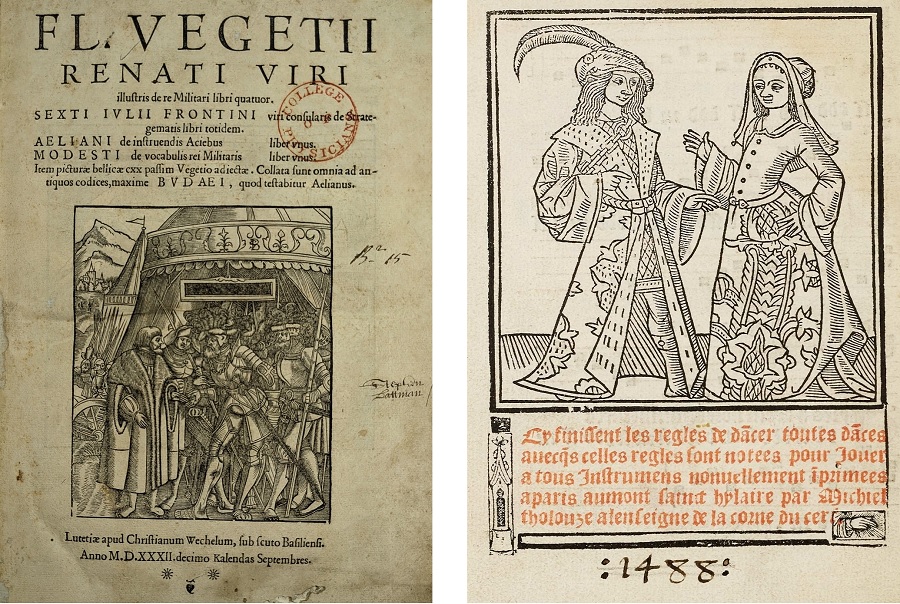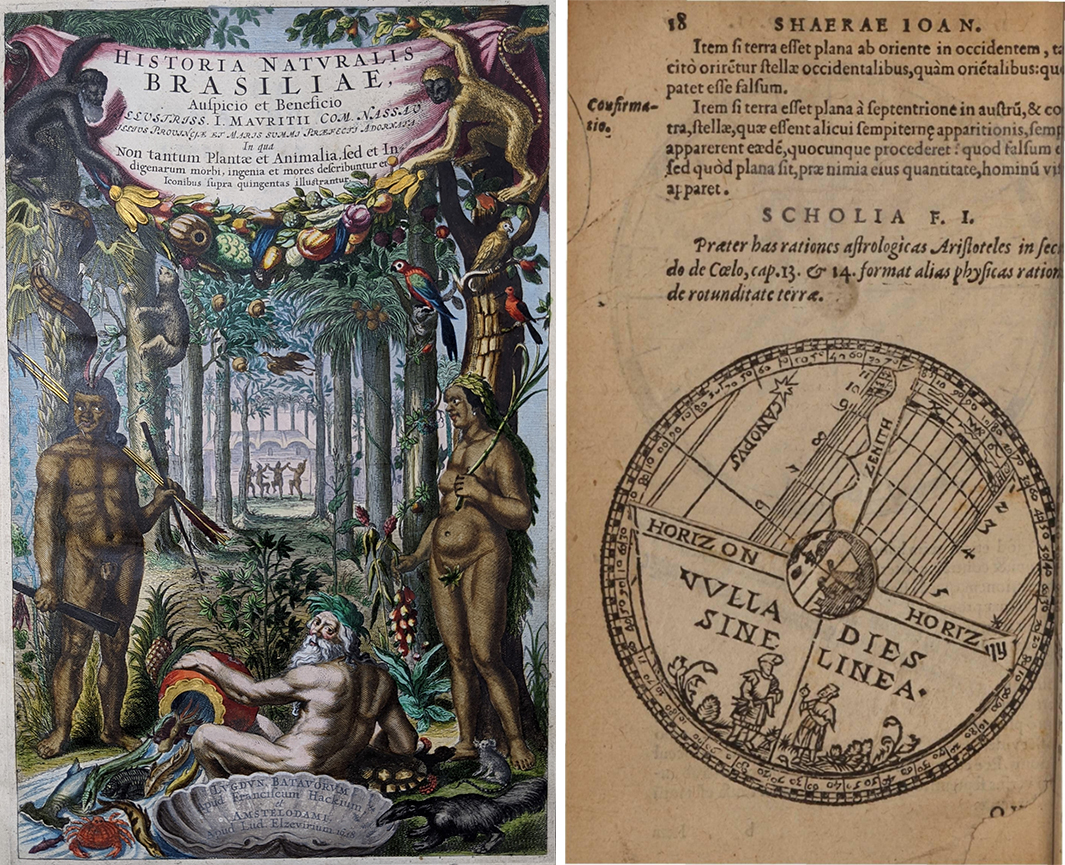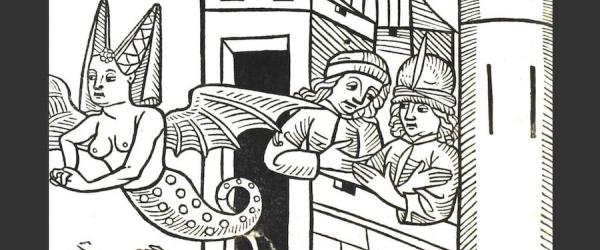
RCP unseen surprising discoveries
RCP Unseen: surprising discoveries
What would you expect to find in a medical collection?
Most of the objects in our collections help us to understand the complex story of doctors and medicine over the last five centuries. Others appear entirely unrelated and may surprise you.
Today, we have established criteria for the objects, works of art, documents and rare books that we collect, but this has not always been the case. In the past, doctors were sometimes enthusiastic curators of curiosities themselves, and their personal collections were gifted or bequeathed to the RCP.
Left: Frontispiece of De Medicina Brasiliensi libri quator ('Four books on Brazilian medicine')
Right: Paper model volvelles showing horizon. Reproduced courtesy of the Wiley Digital Archives © John Wiley & Sons, Inc. All rights reserved.
Four books on Brazilian medicine
Willem Piso, Jean de Laet, Georg Marcgraf, De medicina Brasiliensi libri quatuor (‘Four books on Brazilian medicine’) Leiden, 1648 (CN9687)
This beautiful book illustrates plants and animals native to Brazil, with explanations of their supposed medical properties. It appears progressive in its search for new and improved medicines and its careful documentation of flora and fauna, but the production of this book – and many others like it – is extremely problematic.
This book is the work of colonial explorers who travelled to the Americas in the 16th and 17th centuries, searching for land and resources to support European trade and commerce. These lands and resources – as well as people – were taken by force and exploited, with little regard to indigenous inhabitants or the complex ecosystems.
View catalogue entry for De medicina Brasiliensi libri quatuor
Joannes de Sacro Bosco, Sphaera (‘The sphere’)
Joannes de Sacro Bosco, Sphaera (‘The sphere’), Antwerp, 1566 (CN7353-2)
This textbook contains moving paper models called volvelles. The diagram can be used to show what is visible in the sky. The T-shaped piece rotates, turning the horizon and changing what is visible.
This is a pocket-sized edition of a hugely popular book of astronomy and spherical geometry first written in 1230 by Johannes de Sacrobosco, a mathematics teacher at the University of Paris. An unidentified owner of the book added their monogram – made of the letters L, E and P – at the front, and has added lots of notes into the margins of the pages.
View catalogue entry for Joannes de Sacro Bosco, Sphaera (‘The sphere’)
View digital copy of Joannes de Sacro Bosco, Sphaera (‘The sphere’)

Chinese horse by Xu Beihong, 1950
Chinese horse, Ink on paper, Xu Beihong, 1950 (X217)
A galloping horse with nose and tail in the air is about to break through the restrictions of its wooden frame…
We know very little about this energetic and enigmatic painting, or how it came to be in the RCP’s collections. It may have been a gift from a visiting dignitary or healthcare institution representative from China. It is certainly an unexpected subject for a medical collection.

Left: Vegetius Renatus et al, De re militari libri quatuor (‘Book four on military’)
Right: Michel Tholoze, L'art et instruction de bien dancer (‘The art and instruction of dancing’). Reproduced courtesy of the Wiley Digital Archives © John Wiley & Sons, Inc. All rights reserved.
Vegetius Renatus et al, De re militari libri quatuor
Vegetius Renatus et al, De re militari libri quatuor (‘Book four on military’) Paris, 1532 (CN7648)
Lavishly illustrated with over 100 woodcuts, this book shows people using military equipment such as battering rams, catapults and siege ladders. Spots of red colour have been added by hand, creating an eye-catching but gruesome effect.
Military science was considered part of engineering and mathematics in the 16th century. This book details techniques and equipment used in defence and attack, based on the writings of the late Roman author Flavius Vegetius Renatus.
Michel Tholoze, The art and instruction of dancing
Michel Tholoze, L'art et instruction de bien dancer (‘The art and instruction of dancing’) Paris, 1495 (CN21430)
This is the only known surviving copy of this book anywhere in the world. It is the earliest known printed dancing manual, and it instructs the reader in dignified French courtly dancing known as basse danse.
The book includes written descriptions of the dance moves, musical notation of some of the dance tunes and their steps, and this woodcut illustration of a couple dancing together in their fine clothes. The date 1488 was added later by hand and is a slight over-estimate of the book's age.
View catalogue entry for L'art et instruction de bien dancer (‘The art and instruction of dancing’)
View digital version of L'art et instruction de bien dancer (‘The art and instruction of dancing’)
Silver and glass salt cellars and spoons
Silver and glass salt cellars and spoons, Yapp & Woodward, 1838–44 (X325)
Today, doctors are not often associated with fine dining. However, the RCP has enjoyed a rich tradition of ceremony for nearly 500 years, and food and drink have always been an important part of this.
In the 17th century banquets were a key part of life for physicians, and it was the custom for a new fellow to foot the bill for a celebratory banquet held to welcome them into the RCP. Today, important lectures and events are still accompanied by a dinner, usually in the large Osler Room, a space designed by architect Sir Denys Lasdun to accommodate grand banquets.
The RCP’s silver collection – largely gifts from fellows and other medical bodies – includes many items related to drinking, feasting and ceremony, including these salt cellars.
View catalogue entry for Silver and glass salt cellars and spoons
LEFT: Veterinary fleam, Europe, c.1820 (S137)
This fleam was used for bloodletting on animals, not humans – a common medical treatment for many species. It has three spring-loaded blades, each one a different size to allow the vet to cut to a specific depth. The blades are larger than the ones used on people and would probably have been used to treat large animals such as horses and cows.
In the past items were often collected because a member of the RCP was interested in them, even if they did not relate to medicine and physicians.
Part of the exhibition 'RCP Unseen'. Explore further:



